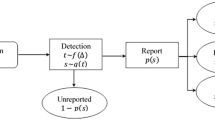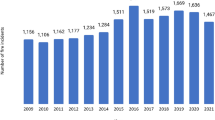Abstract
The vast majority of U.S. homes have at least one smoke alarm. For smoke alarms to be effective, they must have a functional power source, be close enough to the smoke to activate, they must be heard, and occupants must take appropriate action. In homes with smoke alarms and fires considered large enough, the alarms operated 83% of the time. Analyses of data from the U.S. Fire Administration’s National Fire Incident Reporting System and the National Fire Protection Association’s fire department survey showed that in 2003 to 2006, no smoke alarms were present in 31% of reported home fires and 40% of home fire deaths. Smoke alarms were present but failed to operate in 9% of the reported fires and 23% of the deaths. Thirty-seven percent of the deaths resulted from the 47% of fires with operating smoke alarms. Circumstances of the fire, the detection equipment, and occupant characteristics must be considered when evaluating smoke alarm performance. Hardwired smoke alarms operated more often than alarms powered by batteries alone. Victims of fatal fires with working smoke alarms were more likely than victims of fires without working smoke alarms to have been in the area of origin when the fire began; fighting the fire; unable to act; or at least 65 years old; and less likely to have been sleeping. Findings from the Consumer Product Safety Commission’s 2004 to 2005 Residential Fire Survey provide background about smoke alarms in the general population and in unreported fires.







Similar content being viewed by others
References
Ahrens, M. (2009) Smoke alarms in U.S. home fires. Quincy, MA: NFPA.
Greene, MA and Andres C. (2009) 2004-2005 National Sample Survey of Unreported Residential Fires. U.S. Consumer Product Safety Commission, July 2009.
Flynn, J. (2010) Characteristics of Home Fire Victims, Quincy, MA: NFPA, p. 11.
Ahrens, M. (2010) Home Structure Fires. Quincy, MA: NFPA, p. 29.
Karter, M. (2010) U.S. Fire Experience by Region, Quincy, MA: NFPA, p. 25.
U.S. Census Bureau (2008) Current housing reports, series H150/07, American Housing Survey for the United States, 2007, U.S. Government Printing Office, Washington, DC. 20401, 2008. Table 2–4.
U.S. Fire Administration National Fire Data Center (2008) National Fire Incident Reporting System 5.0. Complete reference guide.
Hall, JR Jr., and Harwood B. (1989) “The National Estimates Approach to U.S. Fire Statistics,” Fire Technology, 25, (2), 99-113.
Smith C (1994) Smoke detector operability survey: report on findings (revised). U.S. Consumer Product Safety Commission, Bethesda, MD, pp ii–iii.
Ahrens, M. (2009) Physical Disability as a Factor in Home Fire Deaths, Quincy, MA: NFPA, p. 5.
Ahrens, M. (2008) Home Fires that Began with Upholstered Furniture, Quincy, MA: NFPA, p. 12.
Ahrens, M. (2008) Home Fires that Began with Mattresses and Bedding, Quincy, MA: NFPA, p. 12.
Lee, A. (2007) The Audibility of Smoke Alarms in Residential Homes, Bethesda, MD: U.S. Consumer Product Safety Commission.
Bruck, D. (2001) “The Who, What, Where and Why of Waking to Fire Alarms: A Review,” Fire Safety Journal, Volume 36 (2001) 623-639.
Bruck D, Reid S, Kouzma J, Ball M. (2004) The effectiveness of different alarms in waking sleeping children. In: Proceedings of the 3rd international symposium on human behavior in fire 2004. Interscience Communications Limited, London, England, pp 279–289.
Ball M, Bruck D (2004) The effect of alcohol upon response to fire alarm signals in sleeping adults. In: Proceedings of the 3rd international symposium on human behavior in fire 2004. Interscience Communications Limited 2004, London, England, pp 291–301.
Bruck, D, Thomas, I, and Ball, M. (2007) Optimizing Fire Alarm Notification for High Risk Groups Research Project: Waking Effectiveness of Alarms (Auditory, Visual and Tactile) for the Alcohol Impaired, Quincy, MA: The Fire Protection Research Foundation, pp. 7-8.
Bruck, D, Thomas, I and Kritikos, A (2006). Reducing Fire Deaths in Older Adults: Optimizing the Smoke Alarm Signal Research Project: Investigation of Auditory Arousal with Different Alarm Signals in Sleeping Older Adults. Quincy, MA: The Fire Protection Research Foundation, May 2006, pp. 7-9.
Bruck, D and Thomas, I. (2007) Optimizing Fire Alarm Notification for High Risk Groups Research Project: Waking Effectiveness of Alarms (Auditory, Visual and Tactile) for Adults Who Are Hard of Hearing, Quincy, MA: The Fire Protection Research Foundation, pp. 7-8.
Bukowski RW, Peacock RD, Averill JD, Cleary TG, Bryner NP, Walton WD, Reneke PA, Kuligowski, ED (2008 revision) NIST technical note 1455, performance of home smoke alarms: analysis of the response of several available technologies in residential fire settings. U.S. Department of Commerce, National Institute of Standards and Technology, Washington, DC, pp xxiii–xxvi, 248–249.
Author information
Authors and Affiliations
Corresponding author
Rights and permissions
About this article
Cite this article
Ahrens, M. Smoke Alarm Presence and Performance in U.S. Home Fires. Fire Technol 47, 699–720 (2011). https://doi.org/10.1007/s10694-010-0185-6
Received:
Accepted:
Published:
Issue Date:
DOI: https://doi.org/10.1007/s10694-010-0185-6




